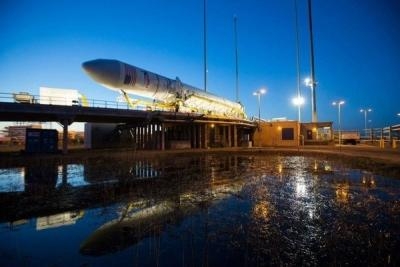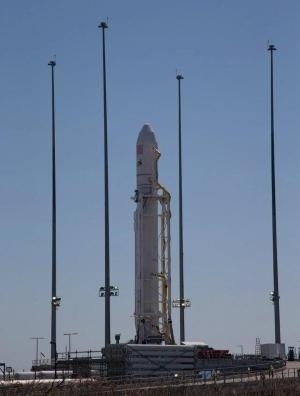Tue, Apr 09, 2013
Erected On Launch Pad At Wallops Island For Upcoming Test Flight
Orbital Sciences Corporation rolled out the first fully integrated Antares rocket from its assembly building at NASAs Wallops Flight Facility (WFF) in eastern Virginia early Saturday morning in preparation for its inaugural flight that is scheduled for April 17 at approximately 1700 (EDT).

The rollout began at about 0430 Saturday morning. The Antares rocket was transported about one mile to the Mid-Atlantic Regional Spaceport (MARS) launch pad complex aboard the Transporter/Erector/Launcher (TEL), a specialized vehicle that also raises the rocket to a vertical position on the launch pad and serves as a support interface between the rocket and the launch complex's systems.
With the completion of the Antares roll out, Orbital says they are on a clear path to a launch date of April 17, provided there are no significant weather disruptions or major vehicle check-out delays between now and then, said Michael Pinkston, Orbitals Antares Program Manager. By Saturday afternoon,the Antares rocket was in a vertical position and fully integrated with the launch mount on the MARS pad.
The Antares test flight, dubbed the A-ONE mission, is the first of two missions Orbital is scheduled to conduct in 2013 under its Commercial Orbital Transportation Services (COTS) Space Act Agreement with NASA. Following a successful A-ONE launch, Orbital will carry out a full flight demonstration of its new Antares/Cygnus cargo delivery system to the International Space Station (ISS) around mid-year. In addition, the company is also scheduled to launch the first of eight operational cargo resupply missions to the ISS in 2013 under the Commercial Resupply Services (CRS) contract with NASA. All COTS and CRS flights will originate from NASAs WFF, which is geographically well suited for ISS missions and can also accommodate launches of scientific, defense and commercial satellites to other orbits.
The Antares medium-class launch system will provide a major increase in the payload launch capability that Orbital can provide to NASA, the U.S. Air Force and other customers. The Antares rocket will launch spacecraft weighing up to 14,000 lbs. into low-Earth orbit, as well as lighter-weight payloads into higher-energy orbits. Orbitals newest launcher is currently on-ramped to both the NASA Launch Services-2 and the U.S. Air Forces Orbital/Suborbital Program-3 contracts, enabling the two largest U.S. government space launch customers to order Antares for right-size and right-price launch services for medium-class spacecraft.

More News
Aero Linx: International Federation of Airworthiness (IFA) We aim to be the most internationally respected independent authority on the subject of Airworthiness. IFA uniquely combi>[...]
Ultrahigh Frequency (UHF) The frequency band between 300 and 3,000 MHz. The bank of radio frequencies used for military air/ground voice communications. In some instances this may >[...]
A Few Questions AND Answers To Help You Get MORE Out of ANN! 1) I forgot my password. How do I find it? 1) Easy... click here and give us your e-mail address--we'll send it to you >[...]
From 2019 (YouTube Edition): Learning To Paint Without Getting Any On Your Hands PPG's Aerospace Coatings Academy is a tool designed to teach everything one needs to know about all>[...]
Also: Sustainable Aircraft Test Put Aside, More Falcon 9 Ops, Wyoming ANG Rescue, Oreo Cookie Into Orbit Joby Aviation has reason to celebrate, recently completing its first full t>[...]
 ANN's Daily Aero-Linx (05.06.25)
ANN's Daily Aero-Linx (05.06.25) ANN's Daily Aero-Term (05.06.25): Ultrahigh Frequency (UHF)
ANN's Daily Aero-Term (05.06.25): Ultrahigh Frequency (UHF) ANN FAQ: Q&A 101
ANN FAQ: Q&A 101 Classic Aero-TV: Virtual Reality Painting--PPG Leverages Technology for Training
Classic Aero-TV: Virtual Reality Painting--PPG Leverages Technology for Training Airborne 05.02.25: Joby Crewed Milestone, Diamond Club, Canadian Pilot Insurance
Airborne 05.02.25: Joby Crewed Milestone, Diamond Club, Canadian Pilot Insurance




